When it comes to seed dispersal, some plants are known to use unique ways to reproduce. One of them is having seed pods that explode.
The experience can be fun and thrilling if you catch the exploding seed pods in action. Here are 15 plants that reproduce by ballistic seed dispersal methods.
1. Sandbox Tree
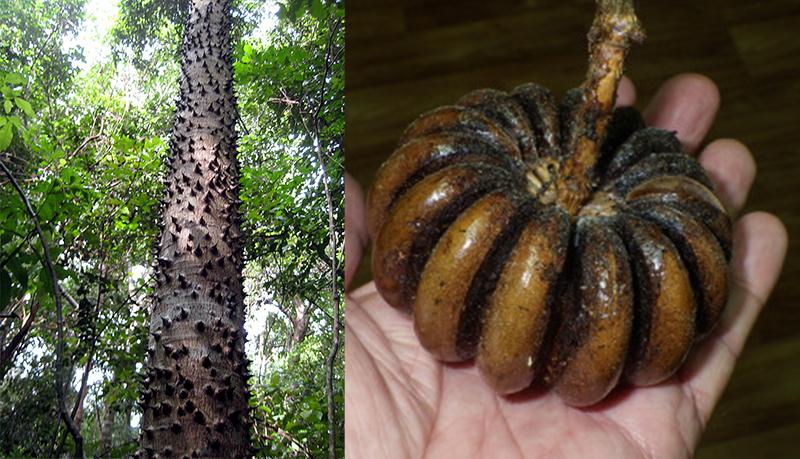
| Scientific name | Hura crepitans |
| Common name(s) | Sandbox tree, monkey no-climb tree, monkey’s dinner bell, monkey’s pistol, possumwood |
| Distinguishing characteristic | Multiple large thorns on its trunk |
The sandbox tree is not suitable for landscape as it is considered to be highly dangerous. This is due to the presence of cone-shaped spikes that cover the trunk of the tree.
It grows to a majestic height of 90 to 130 feet when planted in tropical environments. While its spikes are enough to discourage people from climbing, it is the sap that truly keeps animals away.
The sap is toxic enough to cause painful welts on human skin. If the sap gets into the eyes, it can cause permanent blindness.
Aside from this, the fruit of the tree is poisonous. It can cause cramps, diarrhea, and vomiting when ingested.
Finally, the tree has exploding seed pods that can injure nearby animals. The seed pods come from fertilized female flowers that look like miniature pumpkins.
Once fully mature and dried, they become tiny ticking time bombs. The exploding seed pods fill the air with loud bangs as they fling their seeds up to 150 miles per hour.
The seed dispersion can cover over 60 feet. Anyone within this range can become injured by nature’s reproductive bullets.
2. Touch-Me-Not
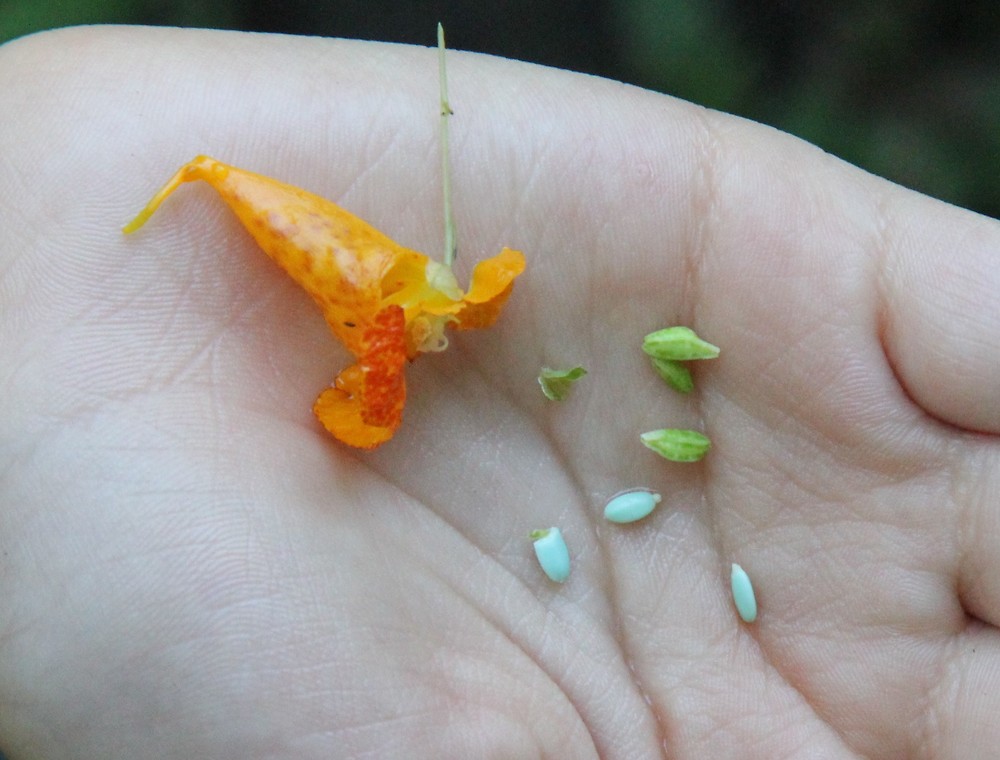
| Scientific name | Impatiens capensis |
| Common name(s) | Spotted touch-me-not, jewelweed, the orange jewelweed, common jewelweed, spotted jewelweed, jewelweed, spotted touch-me-not, orange balsam |
| Distinguishing characteristic | Seed pods explode, especially when touched |
This annual plant can be found in boggy, shady regions where wet soils are common. It can grow from 2 to 5 feet tall with delicate stems.
It produces bright yellow-orange to orange flowers with rusty spots in the summer. After the flowering period, the plant produces slender seed pods.
When these seed pods are ripe, they can explode when touched. This is why the plant has its common name of touch-me-not.
Native Americans have used the plant’s juice to relieve various skin irritations. These include insect bites as well as itching from stinging nettle and poison ivy.
It is rarely cultivated in residential gardens. However, some homeowners use the plant to attract beneficial pollinators such as hummingbirds and butterflies.
3. Cracker Plant
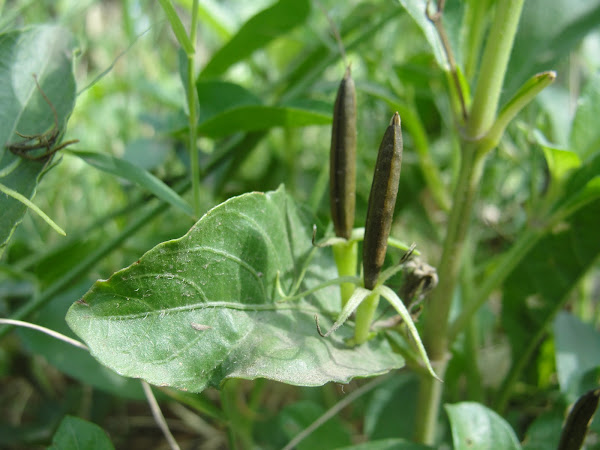
| Scientific name | Ruellia tuberosa |
| Common name(s) | Wild petunia, meadow weed, minnieroot, cracker plant, popping pod, waterkanon, fever root, snapdragon root, sheep potato, duppy gun |
| Distinguishing characteristic | Delicate flowers in pale blue to lavender colors |
The perennial cracker plant has a shrubby growth habit. Found in its native regions in the south and central Americas, this plant can grow up to over a foot tall at most.
It can be found growing profusely in moist and shady grasslands and roadsides. Aside from its flowers that resemble petunias, the cracker plant is known to have exploding seed pods.
These pods have seeds that are arranged in four rows. As the pod grows, it builds up tension when the water fills its cells.
When this happens, the cell walls of the pod start to expand. As a result, the pod builds up energy as it matures and dries up.
Once the pod dries, it can be triggered by contact with moisture such as rain. This ensures that the seed pods are scattered during periods when water is abundant.
When the pod becomes wet with water, it explodes. These flat seeds are then ejected from the pods in four directions.
4. Wood Sorrels
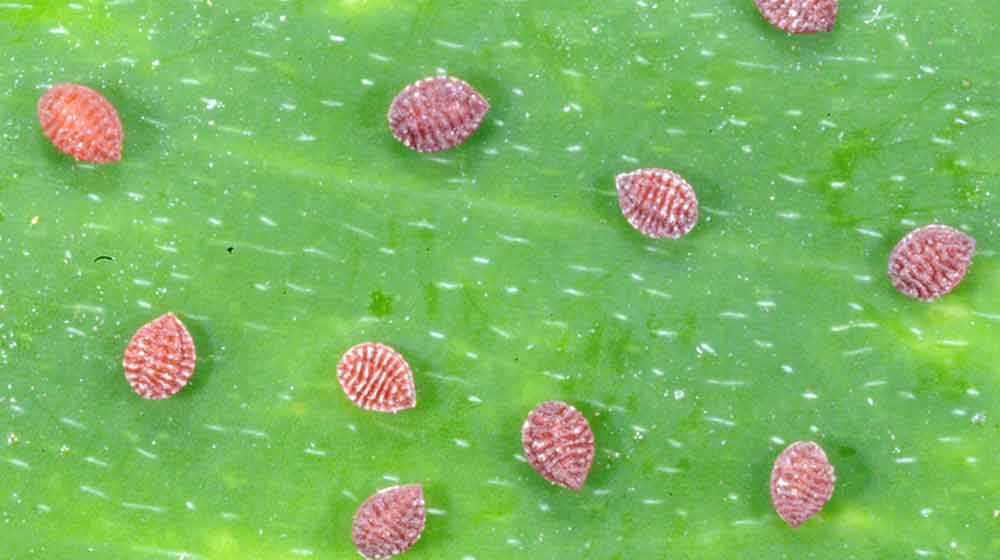
| Scientific name | Oxalis |
| Common name(s) | Wood Sorrel, sourgrass, American wood-sorrel, white wood-sorrel, mountain wood sorrel, northern wood sorrel, mountain woodsorrel, common wood-sorrel, wood-shamrock, true wood-sorrel, wood-shamrock, common woodsorrel, wood shamrock, sleeping-beauty |
| Distinguishing characteristic | Three heart-shaped leaves similar to clovers |
Wood sorrels come in different colors, but they all share similar appearances. Their distinctive heart-shaped leaves fold up at night after being open during the day.
There are several hundred species of oxalis and most of them are found in the wild. Wood sorrels are medium-sized plants that some homeowners consider weeds.
However, some grow them for their flowers. These flowers can come in single petals while others are double-petalled.
Aside from their petal types, the flowers come in varying colors. The most common flowers come in white, but there are some varieties with vibrant shades as well as patterns.
The plant can grow over a foot tall but its normal height is around 8 to 9 inches. Its leaves are typically green although some can have burgundy or purple coloration.
In warm regions, it blooms all year. Otherwise, the typical flowering period is from spring to fall.
After flowering, seed pods are produced. These pods are small, hairy, and cylindrical.
Inside the pods, there are approximately 10 to 50 seeds. Like many plants on this list, the seed pods explode naturally or upon contact when mature.
This can disperse seeds up to 16 feet away. When left alone, wood sorrels can quickly take over the ground especially when the soil is moist and rich.
5. Squirting Cucumber
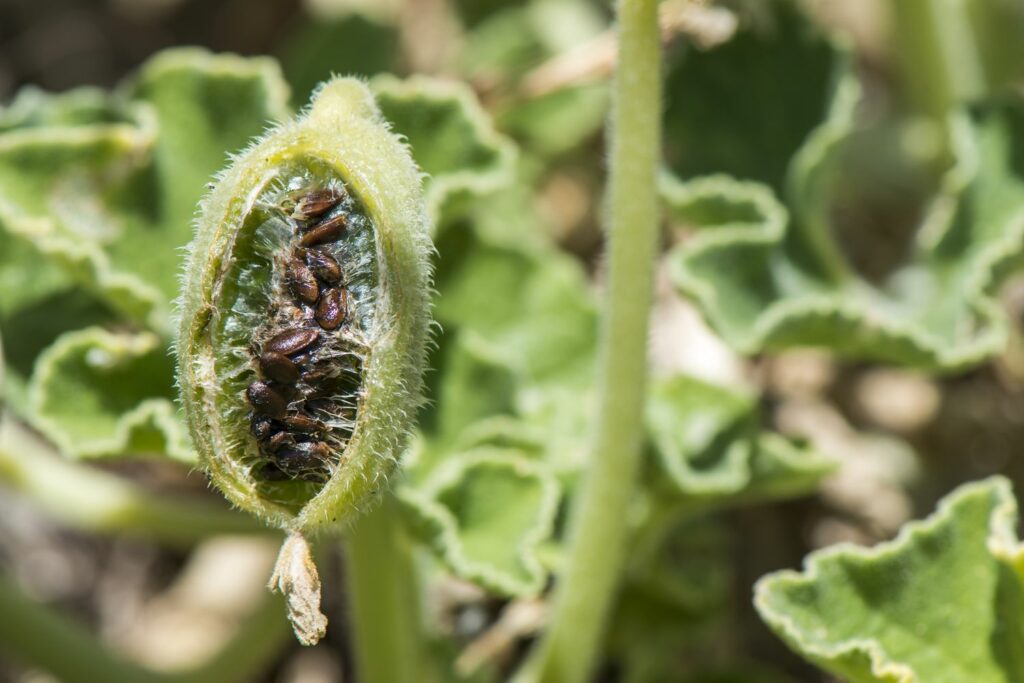
| Scientific name | Ecballium elaterium |
| Common name(s) | Squirting cucumber, exploding cucumber |
| Distinguishing characteristic | Small, prickly fruits |
This climbing plant is naturally found in the Mediterranean regions. Due to its curious characteristic, it is now found in many regions.
The squirting cucumber has bristly stems with rough gray-green leaves. Its flowers resemble most pale yellow cucumber blossoms.
What sets it apart is the fleshy, ovoid fruit covered with bristles. Technically, the fruit is considered a seed pod since it contains seeds.
Once the fruit is mature, it explodes. This causes the seeds to disperse and distribute from 6 to 18 feet away.
While the squirting cucumber can be grown in temperate regions, it is best in USDA zones 9 to 11. In colder regions, it can be grown as an annual plant.
It can grow up to a foot tall with a spread of up to 3 feet. It prefers rich soil and is typically grown as a ground cover due to its flowers and exploding fruits.
6. Hairy Bittercress
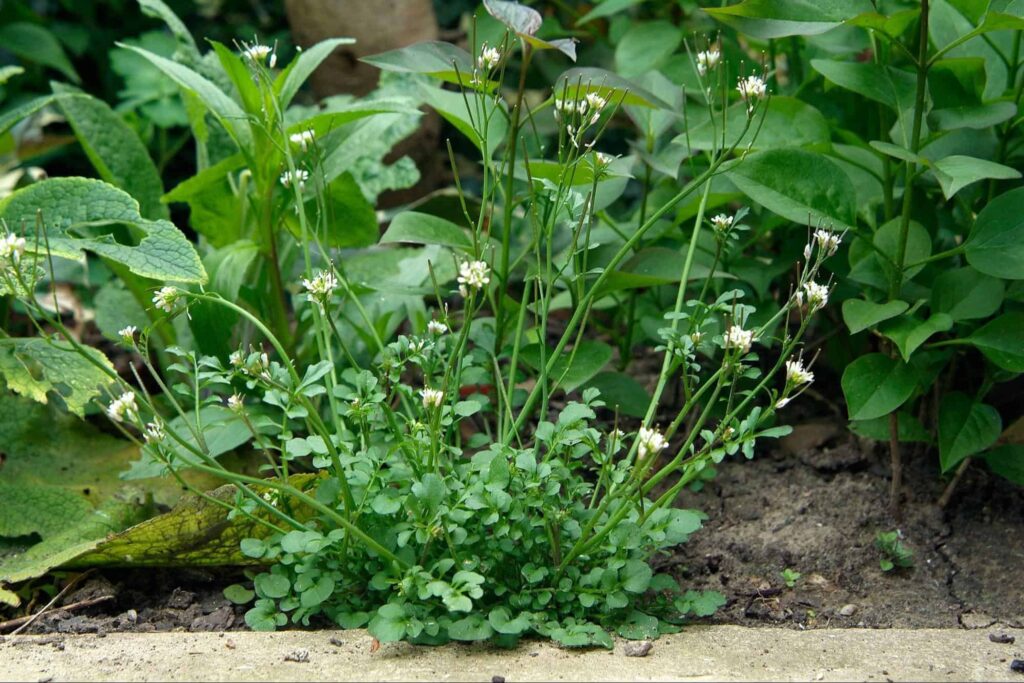
| Scientific name | Cardamine hirsuta |
| Common name(s) | Hairy bittercress, bittercress, flick weed, hoary bittercress, lamb’s cress, land cress, shot weed, springcress |
| Distinguishing characteristic | Basal rosette and flowers with four stamens |
This plant belongs to the mustard family. As such, the greens are edible with a mild and peppery taste.
The hairy bittercress can be easily identified by its basal rosette. From this, stalks shoot up to produce small flowers with four white petals that resemble an equal-armed cross.
After flowering, seed capsules are produced. These look like small purple-green toothpicks standing on top of the flower.
Once mature, the seed pods start to coil tightly. Once this happens, the pod can explode by a passing breeze or a gentle touch.
The seeds are then dispersed up to 3 feet away from the plant. Since the plant adapts easily, the seeds quickly grow up and reproduce in moist rich soils.
Some homeowners consider this a weed, while others pick it for their salad. Either way, it can be easily pulled out since it has shallow roots.
7. Honey Spurge
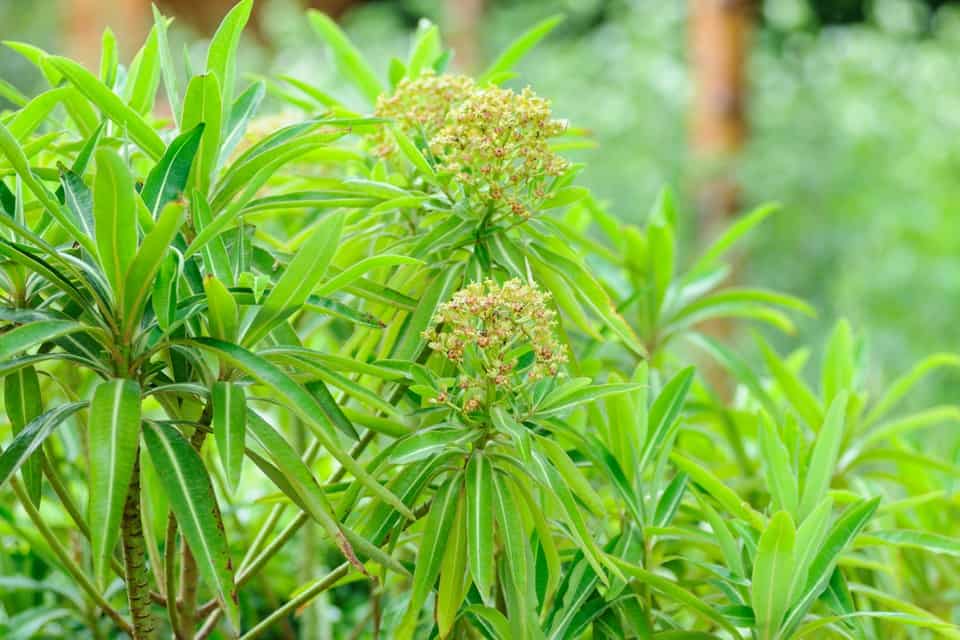
| Scientific name | Euphorbia mellifera |
| Common name(s) | Honey spurge |
| Distinguishing characteristic | Attractive leaves, honey-scented flowers |
This evergreen shrub is grown as landscape plants due to its dramatic foliage. Aside from this, the flowers emit a pleasant scent that is similar to honey.
The honey spurge is native to warm regions such as the Canary Islands. It can be grown in full sunlight or under partial shade.
However, its growth is most optimal in full sun. The plant will become more compact and dense under this condition.
Honey surge plants can grow up to 8 feet tall and wide. Kept in shady areas, the plant will end up with fewer leaves, leggy branches, and fewer flowers.
In the summer, honey-scented flowers are produced. These attract beneficial insects such as bees.
After flowering, the seed pods are formed. Mature seed pods explode naturally but can also be triggered upon contact.
The seeds can be expelled as far as 8 feet away. However, its spread can be further if the seeds are carried by insects, rain, or animal foot traffic.
8. Dwarf Mistletoes
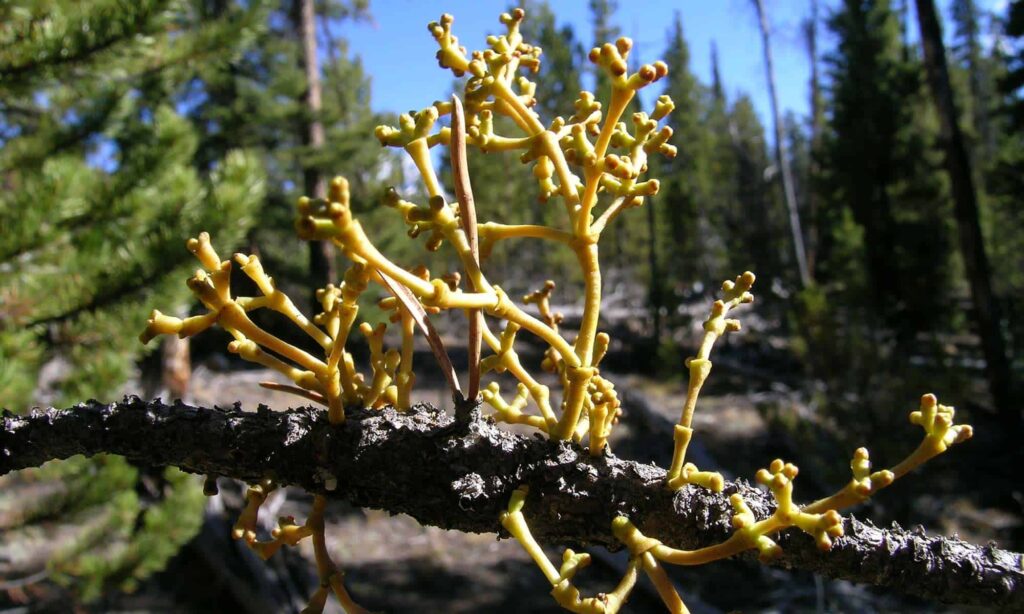
| Scientific name | Arceuthobium spp. |
| Common name(s) | Dwarf mistletoes |
| Distinguishing characteristic | Attractive leaves, honey-scented flowers |
While the name conjures up wonderful images, the dwarf mistletoe is considered a parasitic plant. Typically, they end up as aerial parasites using conifer trees as hosts.
Dwarf mistletoes have several species and most of them are no less than 8 inches long. However, some can colonize into large groups over a foot long.
While dwarf mistletoes are parasitic, they do not spread rapidly. Since their reproduction rate is not that high, they are often not considered invasive.
However, they pose a serious threat to their hosts. By siphoning nutrients, the host trees can experience stunted growth or may eventually die.
The plant spreads by expelling its seeds. The seeds can reach up to 40 feet in distance.
Aside from dispersal, the seeds can fall on birds and animals, which can bring them to longer distances. As a result, the spread can be much further.
9. Violets
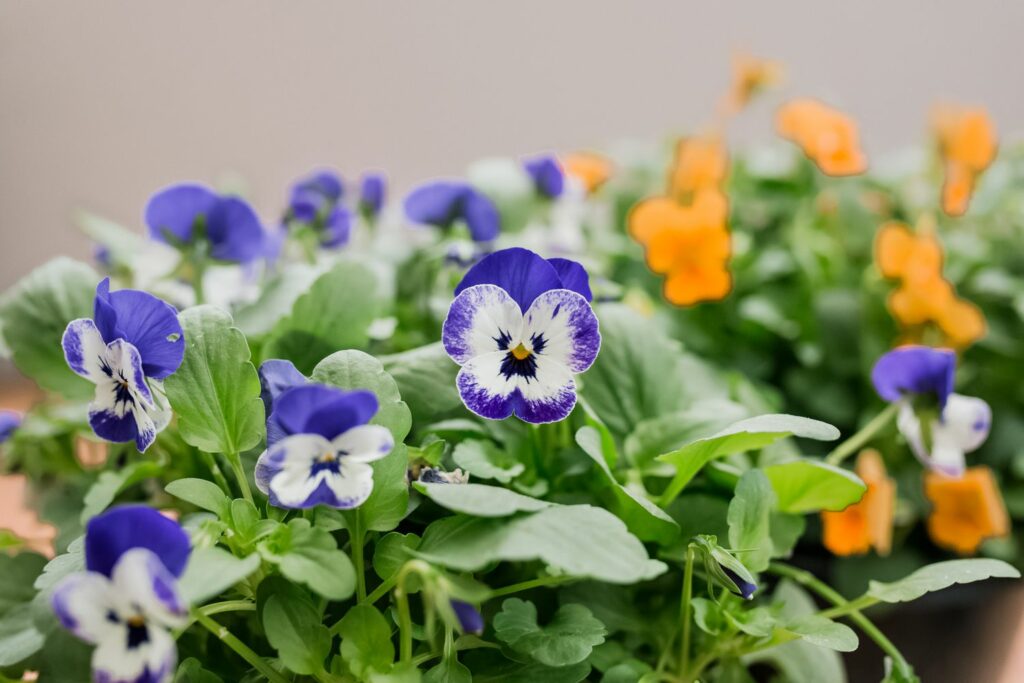
| Scientific name | Viola spp. |
| Common name(s) | Viola, Johnny-jump-up, pansy, violet, sweet violet |
| Distinguishing characteristic | Attractive and colorful flowers |
The Viola genus has over 500 species that include perennials and annuals. They are often grown as landscape plants due to their flowers.
Aside from being showy, Viola flowers are edible. As a result, they often end up in salads, sandwiches, and even cakes as garnish.
Viola species are ideal for USDA zones 3 to 8. They grow best in cooler weather.
These plants can grow from 4 to 10 inches tall in moist, well-draining soil. The vibrant, attractive flowers often come out in the spring or fall.
Once the flowers are spent, the plant produces its seeds. The plant spreads its seed through ballistic dispersal.
The distance can vary although most Viola species are known to expel seeds up to 8 feet away. However, foraging ants can take the seeds even further.
10. Firecracker Flower
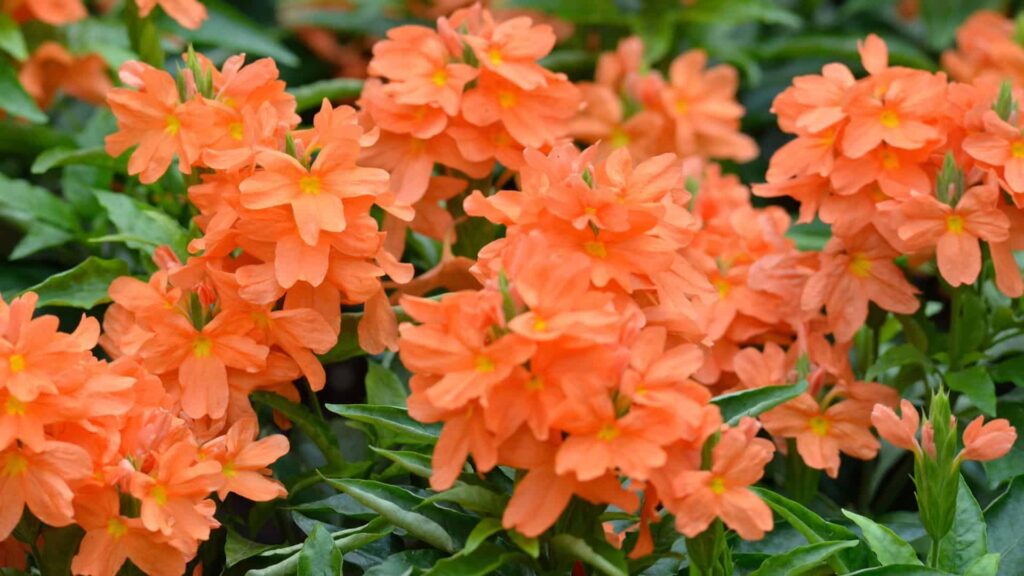
| Scientific name | Crossandra infundibuliformis |
| Common name(s) | Firecracker flower, firecracker plant |
| Distinguishing characteristic | Unusual and vibrant flowers |
With its fiery blooms and easy-growing care, the firecracker flower is a popular landscape plant. Native to southern India and Sri Lanka, this plant has found its way to different countries.
The firecracker plant can grow up to 3 feet tall when mature. While grown as an annual in warm areas, it is usually considered a perennial in colder regions.
It prefers to grow in tropical conditions, where the sun is plentiful and the humidity is high. Under these conditions, the flower produces its showy flowers in coral and peach shades.
The flowers give way to seeds. When the seeds are finally mature and dry, the pod explodes and distributes the seeds up to 5 feet away.
Sometimes, the seeds are taken further away by the rain. When this happens, the seeds eventually grow into colonies of young firecracker plants.
11. Mallow

| Scientific name | Malvaceae |
| Common name(s) | Mallow |
| Distinguishing characteristic | Diverse family, some with exploding seed pods |
The Malvaceae family has some plants that disperse seeds through explosive methods. This is an adaptive and evolutionary characteristic that is used by the plant to reproduce easily.
One of the most notable members of this family is the okra. This common garden vegetable produces seed pods that explode when touched.
As a result, seeds are distributed over 3 feet away. Okras are considered annual vegetables when grown in USDA zones 4 to 11.
Another member of the mallow family that uses ballistic seed dispersal is the kapok tree. Also known as the cotton tree, this plant initially produces cream-colored blossoms.
However, these flowers emit an unpleasant smell. Once the flower dies, the seed pods develop.
Mature seed pods burst open and send the seeds several feet into the wind. The distance can be as short as 3 feet and as far as 8 feet.
12. Hollyhock
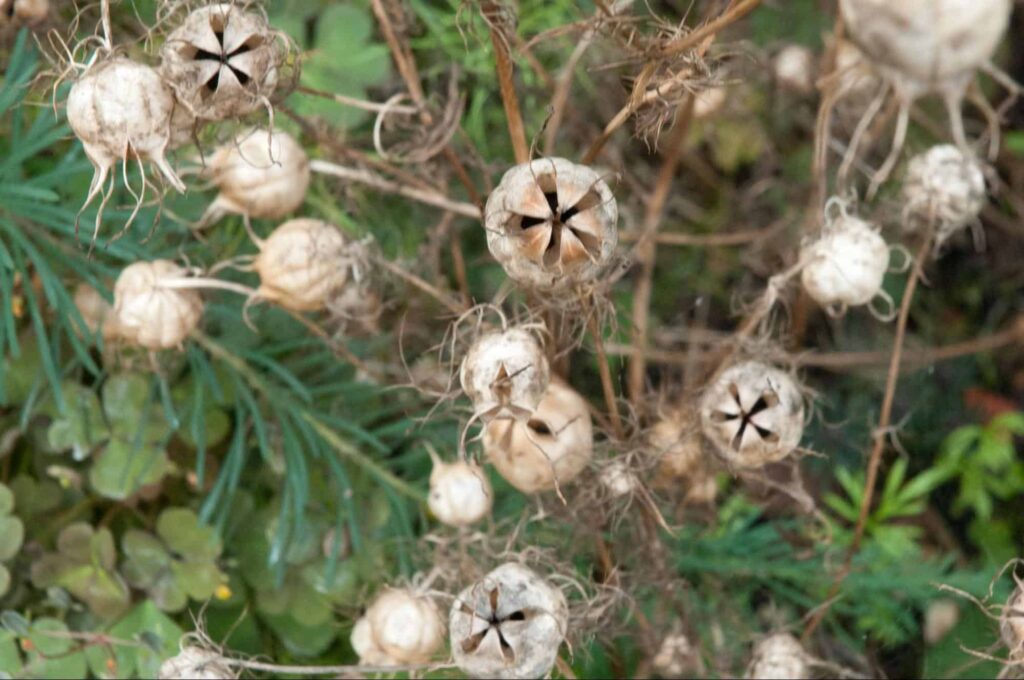
| Scientific name | Alcea |
| Common name(s) | Vervain mallow, hollyhock mallow |
| Distinguishing characteristic | Attractive flowers, low-maintenance plant |
This plant is popular among homeowners due to its attractive foliage and flowers. While it can live up to 3 to 4 years, the hollyhock plant self-sows under the right growing conditions.
Through self-sowing seeds, this plant comes up year after year. The pink, saucer-like flowers initiate the reproduction process in the summer to early fall.
After the flowering period has passed, the plant develops its seed pods. In order to produce these valuable seeds, the hollyhock has to make sure that several factors are present.
These include the right amount of sunlight as well as soil that is kept consistently moist. Under these conditions, the plant begins to produce its exploding seed pods.
The seeds can travel over 3 feet in the air and land among moist, well-draining soil. This ensures the plant’s continued survival.
Under optimal conditions, the plant can grow up to 4 feet tall. Hollyhock plants grow best in full sun, especially in USDA zones 4 to 7.
13. Lupine
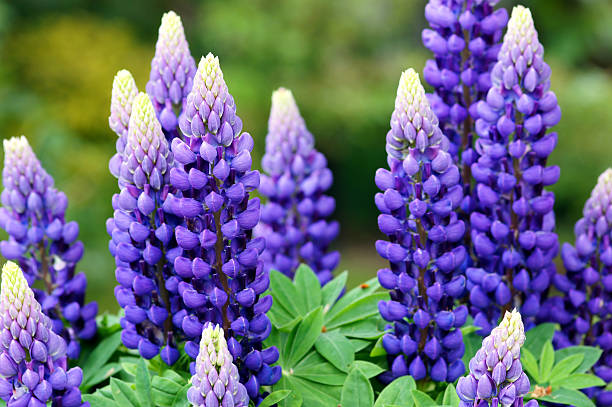
| Scientific name | Lupinus |
| Common name(s) | Lupine, bluebonnet |
| Distinguishing characteristic | Attractive spire of colorful flowers |
The lupine plant grows fast and is considered both a perennial and an annual. Due to their rapid growth, they are often cultivated in containers and pots.
They can grow as tall as 4 feet when fully exposed to sunlight, especially in USDA zones 4 to 8. This wildflower prefers soils that are well-draining, consistently moist, and rich in nutrients.
Lupine plants usually produce tall towers of blossoms in the springtime. Showy and colorful, the flowers come in varying shades and hues of reds, pinks, yellows, blues, and purples.
They also produce plain white blossoms as well as variegated bi-colored flowers. Once spent, the flowers give way to seeds.
Lupine plants disperse their seeds through ballistic means. The distance of the dispersion is about 3 feet away from the parent plant.
However, the seeds tend to be carried by insects, especially ants. Ants consider the seeds as food and carry them to their colony.
Under ideal conditions, the seeds germinate and create new generations of lupine plants.
14. Filaree
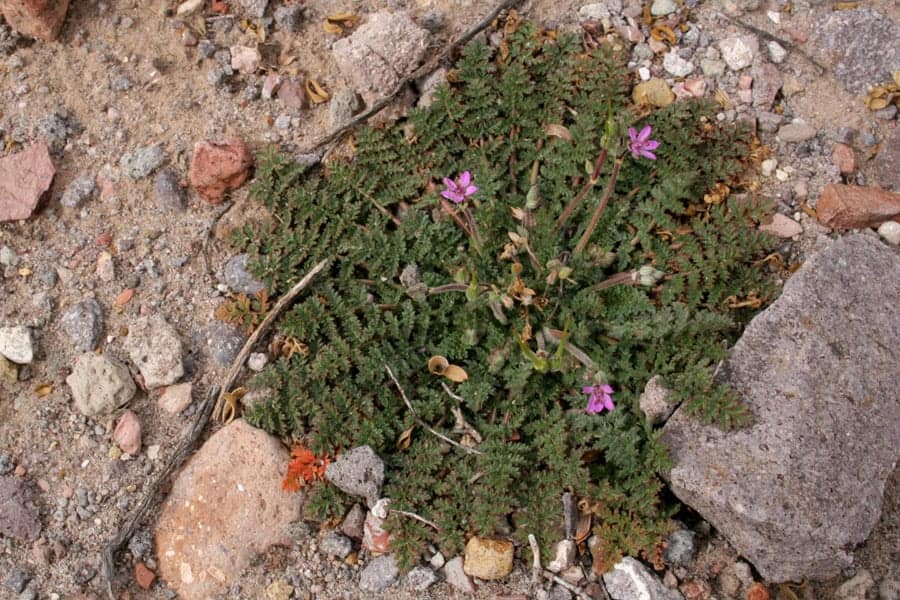
| Scientific name | Erodium |
| Common name(s) | Common stork’s-bill, redstem filaree, redstem stork’s bill, pinweed |
| Distinguishing characteristic | Basal rosette with small flowers on stalks |
The filaree is related to geraniums, making it one of the quick-growing plants in the family. It can be found in temperate as well as tropical regions.
Some regions consider this plant to be a weed. This can be due to its nature of spreading itself in areas to compete with native vegetation.
Once established, the filaree can quickly keep off native grasses, herbs, and plants. It especially grows well in well-draining soils that are in sunny locations.
This plant is known for its unique ballistic seed dispersal system. Filaree plants can throw their seeds over 3 feet away.
Once on the ground, the seeds coil up and bury themselves into the ground. Using its fine bristles, the seeds self-sow and eventually grow into new seedlings.
15. California Lilac
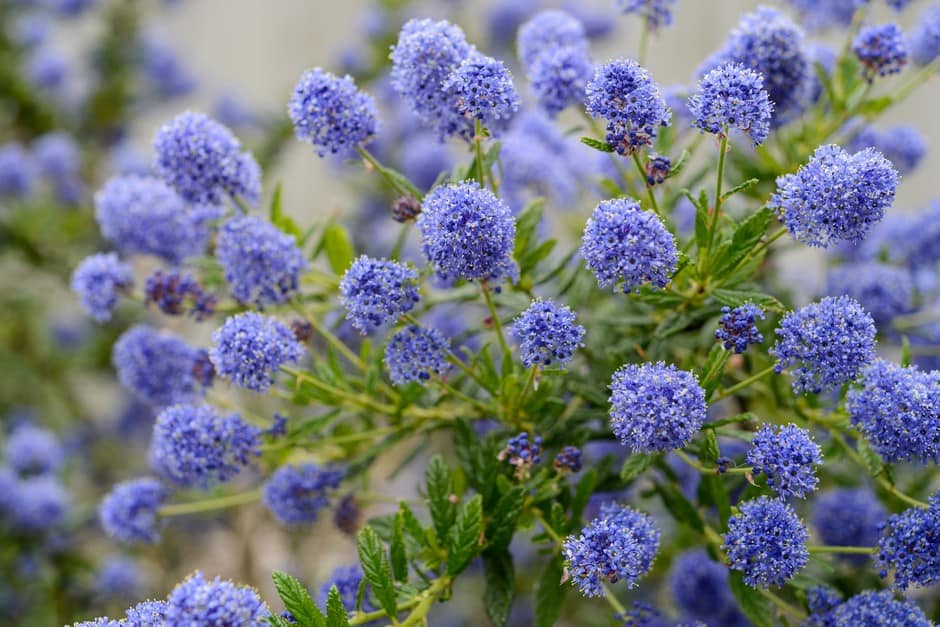
| Scientific name | Ceanothus |
| Common name(s) | California lilac, bruckbush, soap bush |
| Distinguishing characteristic | Attractive and highly fragrant flowers |
There are about 50 to 60 species of the genus Ceanothus. While its common name includes lilac, this plant is not a true lilac at all.
In fact, it belongs to the buckhorn family, which is mostly native to California. Most grow into large shrubs and very few can be considered small trees.
Normally, California lilac flowers come in shades of blue. However, they can also be found in varying shades of pink, purple, and creamy white.
The flowers are small but are clustered, magnifying their scent. The intense fragrance is comparable to floral mints.
Additionally, crushed flowers mixed with water create a foaming lather. This explains another common name, the soap bush.
Once the flowers are spent, the plant begins to produce seeds. By using a ballistic seed dispersal method, the plant ensures future generations of California lilac plants will continue to live on.
FAQs
What is the dispersal of seeds through explosion?
Termed as ballochory, ballistic dispersal is a method where plants distribute their seeds away from them. This can happen naturally or can be triggered by external factors.
The distance can be as short as several inches or over 200 feet away from the parent plant. This allows future generations of the plant to spread out even more.
How are seeds dispersed through explosion?
Ballistic dispersal methods require seed pods, which are sometimes called fruits. As the seed pods ripen, it shoots out the seeds into the surrounding environment.
Sometimes, the dispersal method can be set off by water. Other times, the seed pods explode when touched by insects or animals.
What are the types of seed dispersal?
Seeds are dispersed through wind, water, fire, explosion, and animals.
Plants have adapted to their environments to make sure they reproduce optimally. As a result, their methods of seed dispersal are highly specialized.
What are the advantages of the dispersal of seeds by explosive action?
There are basically two advantages to ballistic seed dispersal. The first is that seeds have a better chance of survival by avoiding nearby predators and diseases.
The second benefit of explosive seed dispersal is that the seeds have a chance to grow in more favorable conditions. At the same time, the seeds reduce competition when it comes to resources and nutrients.





